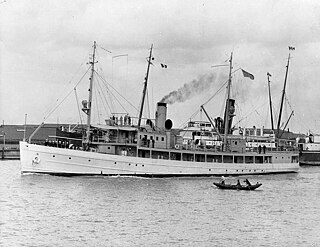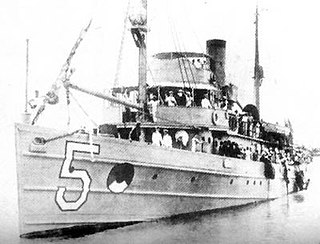
Vigor Shipyards is the current entity operating the former Todd Shipyards after its acquisition in 2011. Todd Shipyards was founded in 1916, which owned and operated shipyards on the West Coast of the United States, East Coast of the United States and the Gulf. Todd Shipyards were a major part of the Emergency Shipbuilding Program for World War II.

The Admirable class was one of the largest and most successful classes of minesweepers ordered by the United States Navy during World War II. Typically, minesweepers detected and removed naval mines before the rest of the fleet arrived, thereby ensuring safe passage for the larger ships. They were also charged with anti-submarine warfare (ASW) duties with rear-mounted depth charge racks and a forward-firing Hedgehog antisubmarine mortar. Their job was essential to the safety and success of U.S. naval operations during World War II and the Korean War. These minesweepers were also employed as patrol vessel and convoy escorts.

The Pearl Harbor Naval Shipyard and Intermediate Maintenance Facility is a United States Navy shipyard located in Pearl Harbor, Hawaii on 148 acres. It is one of just four public shipyards operated by the United States Navy. The shipyard is physically a part of Joint Base Pearl Harbor–Hickam.
USS Bobolink (AM-20/AT-131/ATO-131) was a Lapwing-class minesweeper acquired by the United States Navy for the dangerous task of removing mines from minefields laid in the water to prevent ships from passing.

USS Canopus (ID-4352-A/AS-9) was a submarine tender in the United States Navy, named for the star Canopus.

USS Quail (AM-15) was a U.S. Navy Lapwing-class minesweeper, named after the quail, a migratory game bird. It was laid down 14 May 1918 by the Chester Shipbuilding Co., Chester, Pennsylvania; launched 6 October 1918; and commissioned 29 April 1919.

USS Penguin (AM-33) was a Lapwing-class minesweeper acquired by the United States Navy, named after the bird.

USS Tanager (AM-5) was an Lapwing-class minesweeper acquired by the U.S. Navy for the dangerous task of removing mines from minefields laid in the water to prevent ships from passing.

The first USS Pigeon (AM-47/ASR-6) was a Lapwing-class minesweeper of the United States Navy. She was later converted to a submarine rescue ship. She was named for the avian ambassador, the pigeon.

The first USS Lark (AM-21) was a Lapwing-class minesweeper in the United States Navy. She was named for the lark.

The first USS Oahu (PR-6), a Yangtze River gunboat, was laid down by Kiangnan Dock and Engineering Works, Shanghai, China, 18 December 1926; launched as PG–46 on 26 November 1927; sponsored by Mrs. Bryson Bruce, wife of Comdr. Bruce; and commissioned 22 October 1928, Lt. Comdr. A. C. Thomas in command.

USS Whippoorwill (AM-35) was a Lapwing-class minesweeper of the United States Navy.

The first USS Luzon (PG-47) was laid down 20 November 1926 by the Kiangnan Dock and Engineering Works, Shanghai, China; launched 12 September 1927; sponsored by Miss Mary C. Carter, daughter of Commander Andrew F. Carter, USN; and commissioned 1 June 1928.

USS Dewey (YFD-1) was a floating dry dock built for the United States Navy in 1905, and named for American Admiral George Dewey. The auxiliary floating drydock was towed to her station in the Philippines in 1906 and remained there until scuttled by American forces in 1942, to prevent her falling into the hands of the invading Japanese.

Naval Base Subic Bay was a major ship-repair, supply, and rest and recreation facility of the Spanish Navy and subsequently the United States Navy located in Zambales, Philippines. The base was 262 square miles, about the size of Singapore. The Navy Exchange had the largest volume of sales of any exchange in the world, and the Naval Supply Depot handled the largest volume of fuel oil of any navy facility in the world. The naval base was the largest overseas military installation of the United States Armed Forces, after Clark Air Base in Angeles City was closed in 1991. Following its closure in 1992, it was transformed into the Subic Bay Freeport Zone by the Philippine government.
Maryann, sometimes seen as Maryanne or Mary Anne, was a yacht requisitioned and converted by the United States Navy during the defense of the Philippines in World War II and destroyed 5 May 1942 at Corregidor to prevent capture. The yacht was "in service" and not commissioned.
Fisheries II was a vessel requisitioned by the United States Navy during the defense of the Philippines during World War II. The vessel was "in service" and not commissioned.

USS AFDM-2,, is an AFDM-3-class medium auxiliary floating drydock built in Mobile, Alabama by the Alabama Drydock and Shipbuilding Company for the U.S. Navy. Originally named USS YFD-4, Yard Floating Dock-4, she operated by Todd Shipyards at New Orleans, Louisiana for the repair of US ships during World War II. YFD-4 was renamed an Auxiliary Floating Dock Medium AFDM-2 in 1945 after the war.

BRP Banahaw was a British-built yacht that later served as the presidential yacht of the Commonwealth of the Philippines.

Naval Base Manila, Naval Air Base Manila was a major United States Navy base south of the City of Manila, on Luzon Island in the Philippines. Some of the bases dates back to 1898, the end of the Spanish–American War. Starting in 1938 civilian contractors were used to build new facilities in Manila to prepare for World War II. Work stopped on December 23, 1941, when Manila was declared not defendable against the Empire of Japan southward advance, which took over the city on January 2, 1942, after the US declared it an open city. US Navy construction and repair started in March 1945 with the taking of Manila in the costly Battle of Manila ending on March 2, 1945. Naval Base Manila supported the Pacific War and remained a major US Naval Advance Base until its closure in 1971.

















